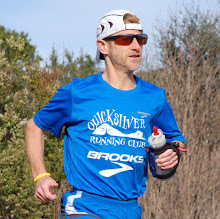One of my twenty todos this weekend is to provide a yearly report for the MUT sub-committee at the LDR committee quarterly meeting this Sunday morning at Lake Merced. The meeting is open to any PA members (see agenda on line), but in case you can't make it, here a sneak peek at it!
2016 50K Trail Nationals @ Tamalpa Headlands - Women podium
First, for those still not familiar with all these acronyms, a quick glossary:
- USATF: our national Track & Field association
- PA: the Pacific Association of USATF, covering Northern California and Nevada
- MUT: stands for Mountain, Ultra and Trail running, three different sports in one group
- LDR: Long Distance Running, encompassing XC (Cross-Country), Road and MUT
What were the 2018 season highlights?
- We had 59 women and 126 men scoring this year (see all the results), for a total of 185 PA members (-30% compared to 2017). That represents 2.6% of the total PA membership (versus 3.84% in 2017).
- We explain the decrease by the incredible offering of ultra races around the State, country and planet as a matter of fact, nowadays; there are literally more than one ultra proposed every weekend! This is the reason we are extending our pool of races to include sub-ultra trails, hoping this will make the Grand Prix more attractive to a broader community, across all age groups, as well as be better aligned with the true meaning of the MUT acronym.
- It is interesting to note that the decrease was accentuated on the women side, especially a lack of team competition (2 teams versus 4 in 2017); in the men, 5 teams scored this year versus 8 in 2017, and 6 in the mixed competition, compared to 8, for a total of 7 distinct teams scoring, versus 8. See my post on the benefits of running as a team, and recruit/enroll new buddies!
With that, what's in store for 2019?
- Well, first and foremost, a new schedule of course! The schedule was initially unveiled early November (see my post for editorial comments) and now officially posted on our PA website (thanks, Nakia!). And we are still working on the last trail race of the calendar, which will happen either in June or July. Overall: 17 events including 1 with two distances which you can run but only score in one (Ruth Anderson 50M or 100K); that makes 15 scorable ultras (versus 16 in 2018, 19 in 2017 and 20 in 2016) and 3 sub-ultra trail races (none in the MUT calendar so far in the past 26 years).
- And a few rule changes, see details in the section below.
Regarding the schedule: it's still heavy but you can notice the decrease of the number of ultras; if we get enough critical mass in participation, we hope to be able to split into two series, an ultra one, and sub-ultra trail one, since these are two distinct sports. We'll also look at inserting one or two Mountain races (strict elevation, distance and slope criteria). That's for 2020.
For those who don't know the rules by heart, you can check the latest version here: https://www.pausatf.org/ultra-running/m-u-t-ultra-rules/
In April (see meeting minutes), we approved a few changes already:
- Age groups: adding a M80+ and W80+; aligning the lowest age to 16 between girls and boys for a new 16 to 29 age group.
- Distance factors: switching from a linear schema (1.0 for 50K, 2.0 for 100K, 3.3 for 100 miles) to a category one, with 3 groups; this will avoid the over weight of the super long ultras on the scores and rankings. It is also allowing us to include sub-ultra trail and mountain races, which will use the 1.0 factor. Overall, that also simplifies the scoring. Here are the new distance factors:
- Coefficient 1.0: distance <75 50="" 6hr="" all="" and="" distances="" e.g.="" km.="" km="" li="" min.="" mountain="" trail="">
- Coefficient 1.5: distance between 75 – 125 km. E.g. 50 mile, 100 km, 12 hr (min. 75 km).
- Coefficient 2.0: distance >125 km. E.g. 100 mile, 24hr (min. 125 km)
- Scoring procedure: in order to accelerate the publication of the results after each race, in addition to recruiting an additional volunteer to assist with scoring, we are changing the delay team captains have to submit their picks, from 10 to 5 days after the race results are published.
This month (December 2018), we will vote on the remaining of the rule changes for the 2019 season:
- Lowering the minima for 6-hour races, from 50K to 42.5K, to take into account aging and allowing more to score, still requiring an ultra distance.
- Clarifying the required spread of races for the 7 best scores with the new coefficients. In the same philosophy than the previous years:
- only your 7 (seven) best scores will count;
- you can't score in more than 1 (one) 2.0-coefficient race, and there is only one in the schedule in 2019 anyway (Headlands Hundred in September);
- and no more than 5 (five) of these best scores can be for races with coefficient 1.5 or 2.0.
To your spreadsheets and calendars, and have a superb 2019, running both sub ultra trail and ultra races with your Pacific Association!
Incidentally, if you have ideas to rekindle our Grand Prix, please leave a comment or attend the meeting tomorrow morning to speak up. Here are a few ideas to spark the conversation:
- More communication (Facebook, email, other social network platforms, PAUSATF booth/tent at events, fliers, ...)?
- More prize money?
- A bigger focus on team competition, with special incentives?
- Less races? Or even more races?
- Separate series (Mountain, Trail and Ultra)?
- Sub championships for narrower geographical areas in our PA boundaries (e.g. Bay Area, Central Valley, Tahoe area) then cross-region finals, within PA the with other USATF associations? Prize money at every race like in Road and XC (Race Directors offering)?
- More formal recognition of the PA competition at each race (award ceremony)?
- More communication around the benefits of the Grand Prix (rewards, objectives)?






























































.jpg )
